Fire Drill: Coatings that Protect Commercial Buildings – and Save Lives
Originally Published: JPCL, July 2016
Steel construction provides engineers and designers with greater flexibility than traditional concrete construction methods. Consequently, steel has become preferred worldwide for commercial infrastructure construction projects. Along with this trend, fire-resistive materials have been developed to protect steel structures. In the event of a fire, these coatings help to protect infrastructure assets from collapse, maintain paths of egress for occupants to exit the building and ultimately save lives.
Steel structures require fire protection because the load-bearing capacity of steel diminishes as its core temperature rises. Fire-resistive coatings are used to protect steel structures from reaching these critical failure temperatures, delaying or preventing the failure of steel and concrete structures that are exposed to the high temperatures found during a fire.
Fire protection materials work by insulating the structural members, keeping them below the temperatures where structural failure will occur for the specified fire rating. The response of a steel structure in a fire can be affected by the maximum temperature, the load resistance of the structure and the condition of restraint of the building.
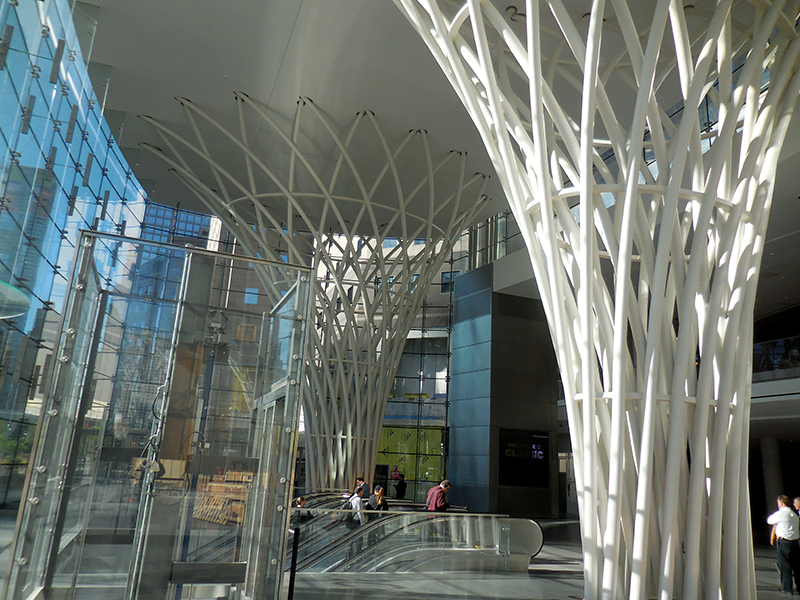
Water-based intumescent applied to interior structural steel pipe columns.
Commercial buildings, based on codes in the United States, generally require one- to three-hour fire resistance ratings, based on UL 263 or ASTM E119 fire test certifications. These tests are performed at world-class testing authorities, such as Underwriter’s Laboratories Inc. or Intertek Testing Services.
Two main types of fire-resistive coatings have been developed to meet the fire protection requirements of commercial infrastructure. The two classifications are cementitious or spray-applied fire-resistive materials (SFRMs) and intumescent fire-resistive materials (IFRMs).
Cementitious Spray-Applied Fire-Resistive Materials
Cementitious SFRMs are the most widely used type of fireproofing products for commercial construction. These materials can be supplied in wet or dry spray formulations and are comprised of either gypsum or Portland cement.
While cementitious coatings will supply the desired fireproofing requirements, they have a rough texture that is generally not considered an aesthetically pleasing finish. For that reason, SFRMs are typically used for enclosed areas that will be covered by walls, drop ceilings or column covers. Cementitious SFRMs also have both thermal and acoustical properties but are primarily used to protect structural elements including columns, beams, metal decking, and steel joists from the intense heat during a fire.
How SFRMs Work
These products are supplied in powder form and mixed with water at the job site to create a slurry that is then sprayed or trowel-applied onto structural steel. The excess water evaporates as the product dries, but some of the water is bound into the cured mass of the material and remains after the material is fully cured. When exposed to extreme heat, these products work by water hydration that evaporates in the fire environment, creating a steam layer within the thickness of the fireproofing. This process insulates the structural steel to meet the specified fire rating.
To enhance insulating and fire-resistive properties, the products often contain other materials like mineral wool, quartz, perlite or vermiculite. Modern formulas are all asbestos-free. Chemical accelerators, such as aluminum sulfate (alum), can also be used with some SFRMs to enhance the set time and hardening of the cementitious material.
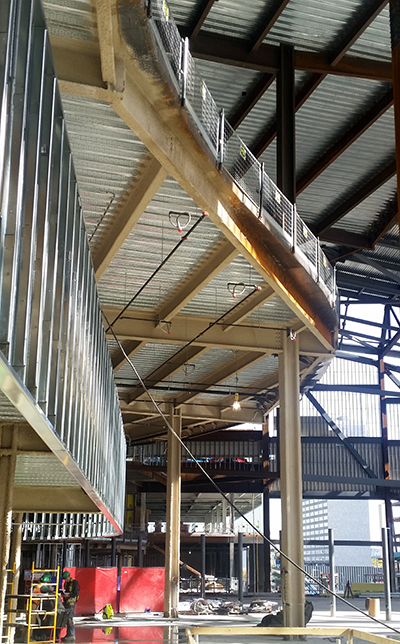
Low-density SFRM applied to structural columns and beams in a commercial sports arena.
Selecting SFRMs
SFRMs are generally categorized by the material’s density and bond strength. The three density classifications that are used to specify cementitious products are as follows.
- Low density (15-21 pcf): Low-density SFRMs contain gypsum as the binder, and can provide high yields and have faster application rates when compared with medium-density products. However, low-density products do have lower physical properties and can be easily damaged if exposed to impact or abrasion. This type of material is suitable for interior areas that will be covered or enclosed.
- Medium density (22-39 pcf): These products contain a binder made from gypsum, cement or a combination of the two. These are more durable products that can withstand minor impact and abrasion damage. Medium-density SFRMs can be used in exposed areas, but not where they would be in contact with people, machinery or equipment.
- High density (40+ pcf): These products use Portland cement as the binder, and are the most durable class of cementitious materials. High-density SFRMs can be used in mechanical rooms, parking garages and other areas that require higher durability. Some high-density SFRMs are exterior rated as well.
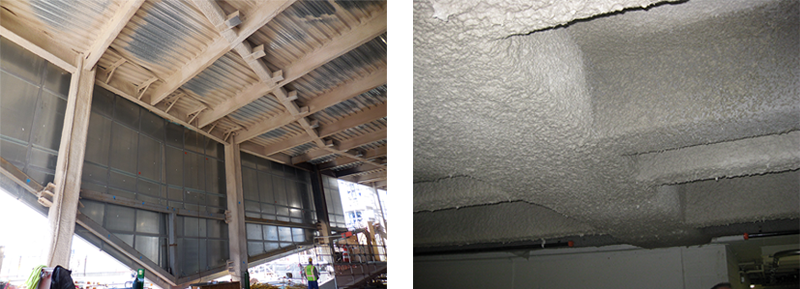
(Left) Medium-density SFRM applied to plenum areas where higher durability is required. (Right) High-density SFRM applied to structural beams and columns in a parking garage.
The bond strength criteria of SFRMs were highlighted after the attacks on the World Trade Center in 2001. The investigation into why the towers failed determined that the cementitious fireproofing had been knocked off of the steel columns and beams during impact, exposing unprotected bare steel to the high-temperature fires.
As a result of this tragedy, the International Code Council (ICC) made a comprehensive set of changes to increase the bond strength requirements for high-rise structures. The goal of these changes is to provide safer high-rise structures that have a higher resistance to fire and collapse, and that are more easily evacuated in case of emergencies. The changes have been incorporated into the ICC’s International Building Code (IBC), a model code used as the basis for building regulations enforced by U.S. state and local jurisdictions.
The new IBC code requirements, as it relates to SFRMs, are increased bond strength in steel structures over 75 feet in height. The requirements call for increasing bond strength characteristics as the height of the structure increases. When specifying an SFRM for a high-rise building, the following bond strength criteria must be met.

Intumescent Fireproofing
A growing trend in today’s commercial architecture is to incorporate exposed structural steel as part of a building’s aesthetic design. For example, many architects are designing large atrium spaces that leave the entire steel structure open, offering a more modern, contemporary feel. Along with this trend, the technology of intumescent coatings has been developed to provide architects with an aesthetically pleasing alternative method for protecting structural steel.
How Intumescent Coatings Work
At normal temperatures, intumescent materials are passive coatings that are designed to provide a resilient, paint-like finish on exposed structural steel. When exposed to extreme heat, however, endothermic reactions take place within the coating. These reactions result in the formation of a heat-blocking char layer which expands up to 50 times the original coating thickness, depending on the type of intumescent material. This char layer absorbs the majority of heat produced by the fire and insulates the structural steel for a given amount of time.
These coatings can be spray- or trowel-applied with no need to cover the finished product. This maintains the architectural appeal created from the exposed steel. Intumescent coatings also provide high durability, space savings, and better impact and abrasion resistance that may occur while in service or during construction.
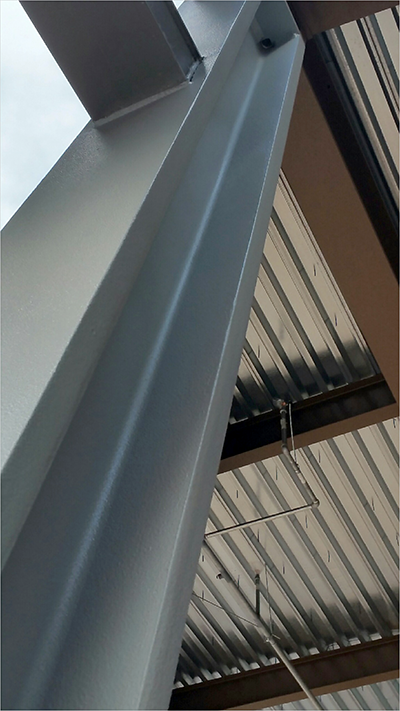
Epoxy intumescent applied to exterior structural supports.
Intumescent Technology, Past, and Present
The first intumescent materials were developed for oil companies in the 1970s, which used them to protect steel structures from hydrocarbon fires on offshore platforms and land-based petrochemical facilities. When designing these structures, engineers realized that this intumescent technology was much more efficient than using dense concrete and that it offered tremendous weight advantages and application characteristics.
Since that time, intumescent technology has greatly improved, resulting in more efficient materials that can be spray-applied using standard airless equipment. With each new generation of intumescent coatings, thicknesses are reduced, making these materials more economical and cost-effective. The aesthetics of intumescent coatings have also been greatly enhanced, allowing them to be used for high-end architectural projects.
Additionally, this technology has allowed architects to reach new heights in contemporary design, using the steel structure as the main element in their artistic vision. Competition among intumescent manufacturers has led to innovative products becoming available in the market. Competition has focused mainly on achieving the lowest dry-film thickness, but new epoxy intumescent systems are also focusing on improving application techniques, faster curing/drying times, recoat intervals and high build characteristics. This results in rapid application with reduced number of coats.
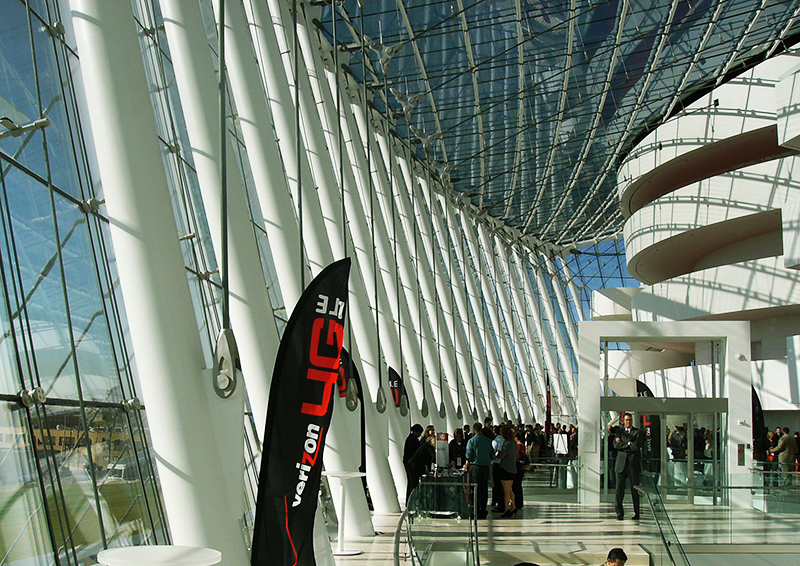
Solvent-based intumescent applied to interior steelwork along the glass curtain wall.
Selecting Intumescent Materials
There are three main types of intumescent coatings used for commercial infrastructure: water-based, solvent-based and epoxy-based materials. Typically, all types of intumescent fire-resistive materials exceed the bond strength requirements set forth in the IBC.
1. Water-based Intumescents
These products have the best-in-class finish, are low-VOC and low-odor. These products are suitable for onsite application only after the steel structure has been erected. They are, however, sensitive to moisture and humidity and require protection during application.
2. Solvent-based Intumescents
These products also have aesthetic features and come in low-VOC formulations (<150 g/l). Solvent-based intumescent products are less sensitive to moisture, humidity and inclement weather. They may be applied at lower temperatures and in semi-exposed conditions at perimeter walls and areas exposed to the exterior during construction. Some solvent-based products are rated for exteriors as well.
3. Epoxy-based Intumescents
These products offer high-end aesthetics as well as the highest durability, film-build characteristics, and fastest recoat windows. Epoxy-based intumescent products are available in 100 percent solids and 95 percent solids formulations with negligible VOC, and may be applied by plural or single-component spray equipment. The required thickness can be achieved in one to two days. These products provide a good solution for off-site or onsite application and externally exposed steelwork.
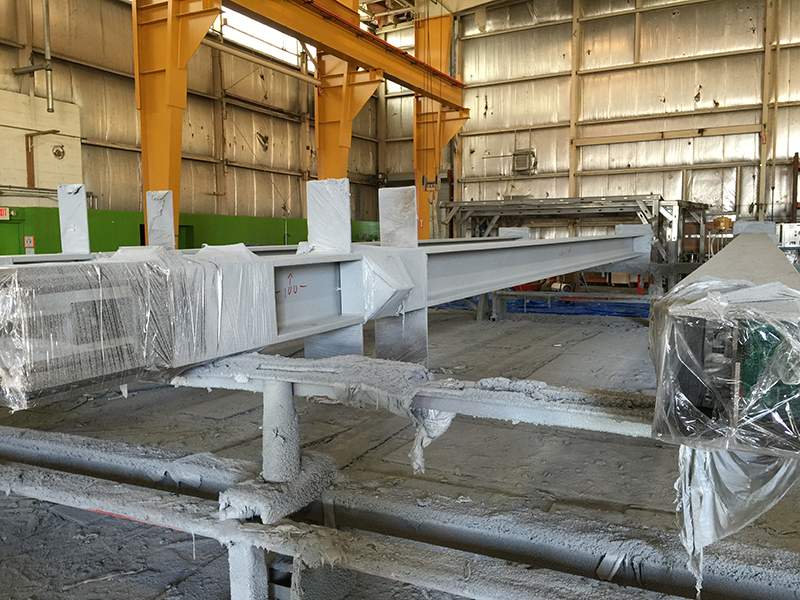
Epoxy-based intumescent applied off-site in a controlled shop environment.
Fire Testing and Certification
All fireproofing products used for commercial infrastructure undergo rigorous testing to achieve their fire ratings, and approvals and certification requirements vary in different countries and regions around the world. This certification allows them to be specified and used in commercial buildings. Regardless of where a fire-resistive product is used, it must have undergone the appropriate testing to relevant fire-test standards and certification by accredited fire-test facilities.
In North America, the most widely known testing organizations are Underwriter’s Laboratories (UL) and Intertek Testing Services (ITS) which have become the standard for testing and certification of fireproofing materials. For a product to be used in a commercial building, it must successfully pass the UL 263 or ASTM E119 test program. This type of fire test simulates a cellulosic fire in which the main fuel would be general building products, such as wood, carpet, office furniture, etc.
For petrochemical facilities, fire-resistive products must be tested and certified to UL 1709. Products with UL 1709 certification have been exposed to a rapid rise time/temperature curve which simulates a hydrocarbon fuel fire environment. This time/temperature curve is significantly more severe than UL 263/ASTM E119.
Typically, fire tests are conducted on columns (I-sections and tubulars), beams, floor and roof assemblies, but other specialty configurations may be tested as well. Columns are tested vertically, with the fire protection applied to all sides. Loaded beams are tested horizontally, with the fire protection applied to three sides and the top flange directly in contact with a floor assembly. Floor decks and roof decks are also tested horizontally, with fire protection applied to the bottom of the assembly exposed to the fire.
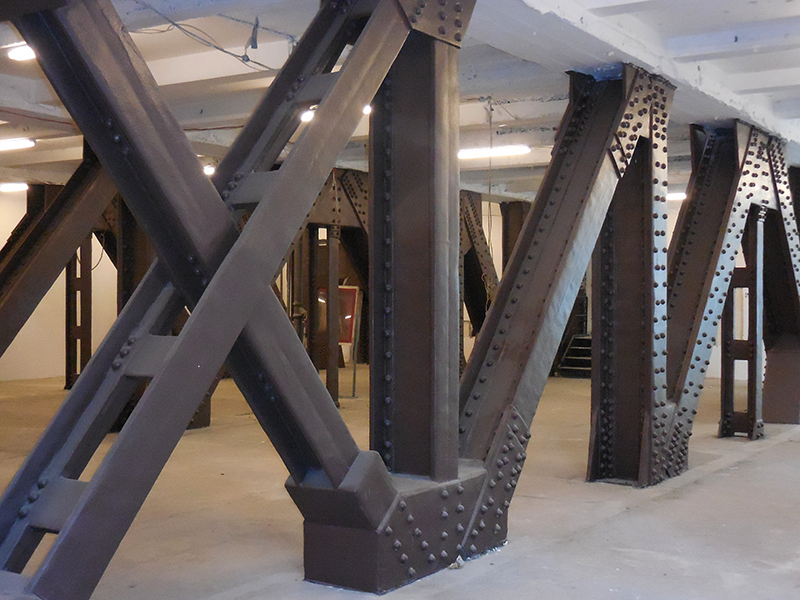
Epoxy-based intumescent used for renovation projects to bring existing steel structures up to code.
In addition to fire testing, all of these products must also pass extensive environmental test programs. This environmental testing determines whether the products are suitable for interior or exterior environments.
Certification bodies provide confidence that a fire-resistive product complies with regulatory requirements and meets all testing criteria. Independent third-party certification provides a quality mark (UL or Warnock Hersey, for example) that is shown clearly on a certified product’s label. As part of this process, certification organizations also conduct regular audit tests at manufacturers’ production facilities to confirm that a product’s formula has not modified. These follow-up tests confirm that the product being supplied is identical to that which was tested.
Summary
Fire-resistance ratings for commercial infrastructure are critically important in facilitating the evacuation of occupants and providing adequate time for firefighting measures. When specifying a fire-resistive product, make sure that the coating meets the project specifications and is appropriate for the intended service environment.
A number of criteria must be evaluated, such as performance requirements, interior or exterior use, application onsite or off-site, project schedule and finish aesthetics. In addition, products must also have the necessary certification and perform to industry-accepted fire-test standards.
As architects and engineers utilize new technology, and building safety codes continue to evolve, fire-resistive materials are taking on an increasingly significant role. This technology will assist architects and contractors to design and build safe structures while reducing construction costs and construction timelines.
By: Sean Younger and Jim Rippe, Carboline Company

